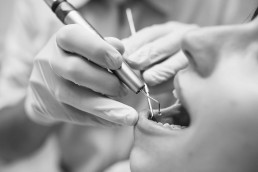Latest Publication by Our Medical Professionals!
Abstract
Objectives: Objective of this trial was to assess the masking results in initial caries lesions (ICL) that were resin infiltrated during fixed orthodontic treatment in comparison to contralateral teeth that were fluoridated only.
Trial design: A randomized, controlled, split-mouth trial.
Methods: Adolescent patients (age range: 12-18 years) with fixed orthodontic appliances who had developed ICL [ICDAS 1 or 2 (International Caries Detection and Assessment System)] during orthodontic treatment were consecutively recruited and randomly assigned to either resin infiltration (Icon) with up to 3 etching procedures (Inf) or to a fluoride varnish (Tiefenfluorid) (FV). Both interventions were performed according to the manufacturer's recommendations. Outcome assessors were blinded to the applied intervention. Primary and secondary outcomes included the evaluation of the appearance of the ICL before (T0) and 1 week after (T1) treatment by digital photographs (ΔE), laser fluorescence readings (DD), and ICDAS scores.
Blinding: Due to the treatment nature neither the operators nor the patients could be blinded. However, outcome assessors and the statistician were blinded.
Results: Fifteen patients (9 female) with 60 ICL were included (mean age: 14.6 years). At baseline FV and Inf did not differ significantly in ΔE (median ΔE0,T (25th/75th percentiles):10.7(9.1/20.9): ΔE0,I:13.4(10.3/18.5); P = 0.469), DD (P = 0.867) and ICDAS (P = 0.521). One-week after treatment (T1) ΔE values (P < 0.001), DD values (P < 0.001), and ICDAS scores (P = 0.014) for Inf were significantly reduced, whereas ΔE values (P = 0.125) and ICDAS scores (P = 0.073) for FV remained unchanged.
Limitation: Natural remineralizing in the standard interventional control group cannot be observed yet, since up to 6 months are needed to naturally remineralize ICL.
Conclusions: Based on our short-term data, resin infiltration effectively masked ICL during treatment with fixed orthodontic appliances. Fluoridation was not able to immediately improve the visual appearance of ICL. Further longer-term assessment should focus not only on the aesthetic outcome, but also on the caries inhibitory effect of resin infiltration during treatment with fixed orthodontic appliances.
Trial registration: German Clinical Trials Register (DRKS-ID: DRKS00011797).
© The Author(s) 2022. Published by Oxford University Press on behalf of the European Orthodontic Society. All rights reserved. For permissions, please email: journals.permissions@oup.com.
Source: https://pubmed.ncbi.nlm.nih.gov/36200478/
European Orthodontic Society Conference in Oslo
On June 14, 2023, Dr. Dimitrios Kloukos presented his research paper titled 'Gingival recession development in orthodontic patients' at the European Orthodontic Society Conference in Oslo, Norway.
Malmö University Thesis
Dr. Dimitrios Kloukos successfully defended his PhD thesis titled "Gingival recession development in orthodontic patients" at Malmö University, Sweden, on April 5, 2023.
The supervision was carried out by Prof. Dr. Andreas Stavropoulos (Malmö University, Sweden) and Prof. Dr. Christos Katsaros (University of Bern, Switzerland). The evaluator of the faculty was Prof. Dr. T. Peltomäki (Tampere University Hospital, Finland).
Professors V. Vandevska-Radunovic (University of Oslo, Norway), Associate Professors R. Gašperšič (University of Ljubljana, Slovenia), and Assοciate Professor M. Sonesson (University of Malmö, Sweden) formed the examination committee for the public presentation of the thesis.
Treatment of stage IV periodontitis: The EFP S3 level clinical practice guideline
Abstract
Background: The recently published clinical practice guideline (CPG) for the treatment of periodontitis in stages I-III provided evidence-based recommendations for the treatment of periodontitis patients, defined according to the 2018 classification. Stage IV periodontitis shares the severity and complexity characteristics of stage III periodontitis, but includes the anatomical and functional sequelae of tooth and periodontal attachment loss (tooth flaring and drifting, bite collapse, etc.), which require additional interventions following completion of active periodontal therapy.
Aim: To develop an S3 Level CPG for the treatment of stage IV periodontitis, focusing on the implementation of inter-disciplinary treatment approaches required to treat/rehabilitate patients following associated sequelae and tooth loss.
Materials and methods: This S3 Level CPG was developed by the European Federation of Periodontology (EFP), following methodological guidance from the Association of Scientific Medical Societies in Germany and the Grading of Recommendations Assessment, Development and Evaluation (GRADE) process. A rigorous and transparent process included synthesis of relevant research in 13 specifically commissioned systematic reviews, evaluation of the quality and strength of evidence, the formulation of specific recommendations and a structured consensus process with leading experts and a broad base of stakeholders.
Results: The S3 Level CPG for the treatment of stage IV periodontitis culminated in recommendations for different interventions, including orthodontic tooth movement, tooth splinting, occlusal adjustment, tooth- or implant-supported fixed or removable dental prostheses and supportive periodontal care. Prior to treatment planning, it is critically important to undertake a definitive and comprehensive diagnosis and case evaluation, obtain relevant patient information, and engage in frequent re-evaluations during and after treatment. The periodontal component of therapy should follow the CPG for the treatment of periodontitis in stages I-III.
Conclusions: The present S3 Level CPG informs clinical practice, health systems, policymakers and, indirectly, the public on the available and most effective modalities to treat patients with stage IV periodontitis and to maintain a healthy dentition over lifetime, according to the available evidence at the time of publication.
Keywords: clinical guideline; dental implant; orthodontic; periodontitis; prosthodontic; stage IV.
© 2022 John Wiley & Sons A/S. Published by John Wiley & Sons Ltd.



